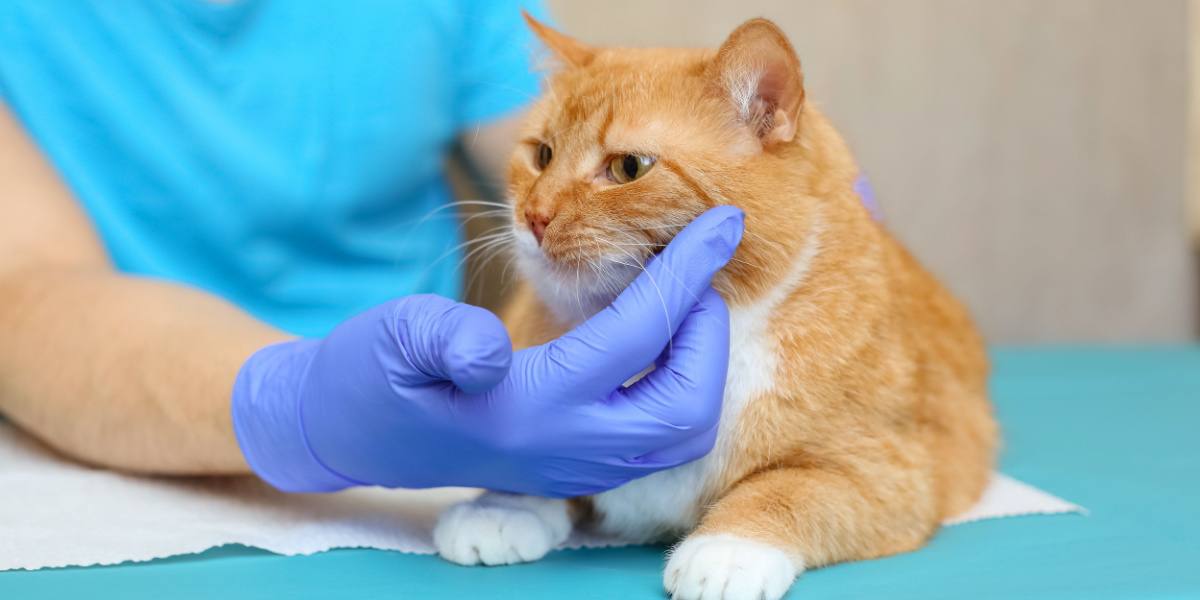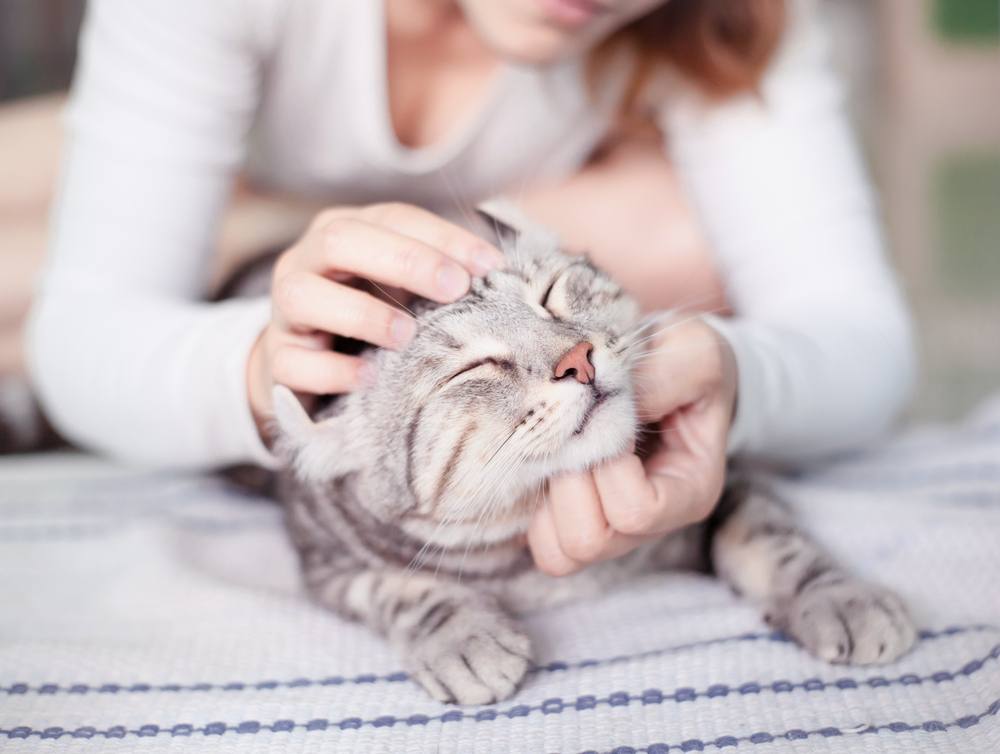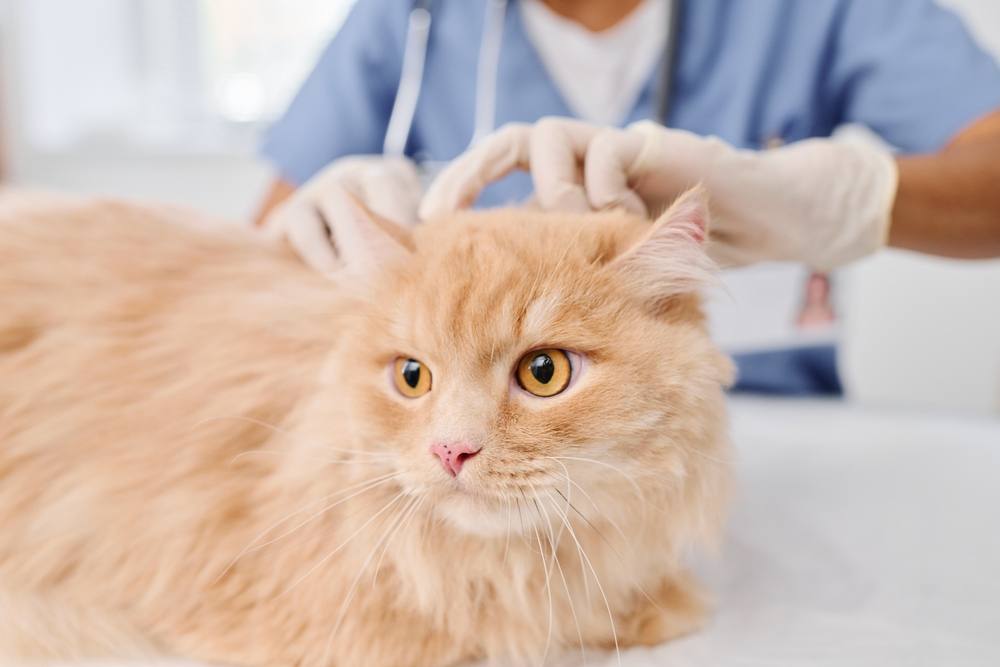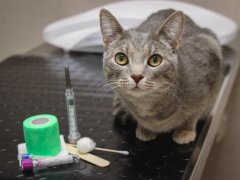
Take your cat for a checkup with your veterinarian if you find any new lumps or bumps. Eliz A / Shutterstock
Sebaceous cysts are benign (non-cancerous) masses that can form on your cat’s skin, commonly on the torso and upper legs. The cysts look like raised lumps on the surface of the skin, and if they burst, they can ooze yellow or white discharge.
While this sounds concerning, sebaceous cysts do not usually cause pain in cats. If they remain small and inactive, many sebaceous cysts do not require any treatment.
However, cysts can become infected if they rupture. If your cat’s sebaceous cyst is causing them discomfort, they might need treatment with medication or surgical removal.
Quick Overview: Sebaceous Cysts in Cats
 Other Names: Cysts
Other Names: Cysts
 Common Symptoms: Cysts that are not irritated have no symptoms. Infected cysts may be itchy, red, burning, growing rapidly, or smelly.
Common Symptoms: Cysts that are not irritated have no symptoms. Infected cysts may be itchy, red, burning, growing rapidly, or smelly.
 Requires Ongoing Medication: No
Requires Ongoing Medication: No
 Vaccine Available: No
Vaccine Available: No
 Treatment Options: Medical treatment of secondary infections or trauma. Surgical removal of the cyst.
Treatment Options: Medical treatment of secondary infections or trauma. Surgical removal of the cyst.
 Home Treatment: Monitor the cyst for changes. Take care not to catch when grooming. Take your cat to the vet regularly.
Home Treatment: Monitor the cyst for changes. Take care not to catch when grooming. Take your cat to the vet regularly.
Causes of Sebaceous Cysts

Check your cat’s coat and skin regularly for any new lumps or bumps. Nitiphonphat / Shutterstock
Cysts are abnormal sacs or lumps that form in the body and contain air, fluid, or semi-solid contents. There are lots of different types of cysts, and they originate from different tissues in the body. Sebaceous cysts form from tiny glands called sebaceous glands, which sit under the surface of your cat’s skin.
Sebaceous glands are usually associated with a hair follicle and secrete an oily liquid called sebum. This natural oil helps your cat’s coat and skin stay healthy, as well as providing some waterproofing. If the opening of the gland becomes blocked or inflamed, the sebum can get trapped inside and a cyst can form. Sebaceous cysts usually contain a yellowish fluid made up of sebum and keratin (found in nails and hair).
Identifying Sebaceous Cysts & Symptoms
Sebaceous cysts appear as round lumps just under the skin. They sometimes have a slight yellow or blue tinge, and are usually soft, movable, and not painful. They tend to be very small to begin with (a few millimeters) so they can be difficult to spot under your cat’s fur. They can occur singly or in groups.
If the cysts burst, they can ooze a white or yellow discharge that sometimes resembles cottage cheese. While they aren’t cancerous, and many will remain small and cause no problems, they are prone to becoming infected, especially if they are knocked or traumatized. Symptoms of infection include:
- Redness
- Bleeding
- Ooze or discharge
- Bad smell
- Rapid growth
- Your cat is itching or scratching the cyst
Only a veterinarian can identify and diagnose sebaceous cysts, so take your cat to the vet right away if you find a lump on your cat or notice any of the above symptoms.
Diagnosis of Sebaceous Cysts

Your veterinarian will likely recommend sampling any new lumps to find out exactly what they are. Pressmaster / Shutterstock
Your veterinarian will take a thorough history, including how long your cat’s lump has been there and how it has changed in that time. They will then perform a full physical examination and check the lump for signs of inflammation or infection.
Although sebaceous cysts are benign, they can look similar to types of cancerous masses. Therefore, your veterinarian will probably sample the lump to confirm that it is a sebaceous cyst. One method of sampling, called a fine needle aspiration, involves placing a needle into the lump to collect a small sample.
Your vet will look at this sample under the microscope (or send it to a specialist pathologist) to confirm exactly what it is. Unless your cat is very nervous, veterinarians are usually able to do this test without sedation. If they need to take a bigger sample (a biopsy) your cat might need a short sedation or general anesthesia.
If your veterinarian is concerned about infection, they might also send a sample for culture and sensitivity testing. This test checks if infection is present, as well as what antibiotic is most appropriate to treat it.
Treatments for Sebaceous Cysts
In most cases, sebaceous cysts do not require any treatment. If your cat’s cysts are small, stable, and not bothering them, your veterinarian is likely to recommend monitoring.
If they are sore, infected, or growing very rapidly, they will likely be treated in one of two ways: medication or removal of the cyst through surgery.
Medical Management of Sebaceous Cysts
If your cat’s sebaceous cyst is inflamed or infected, your veterinarian might recommend medication. This might include anti-inflammatory medications, oral antibiotics, or topical antibiotic washes.
The aim of medical treatment is to resolve any secondary complications of the cyst, such as trauma or infection, so that it goes back to being stable. Medication is normally effective at resolving inflammation or infection within a week or so.
In most cases, medical therapy will not cause the cyst to go away. This is a suitable option for cats that are not fit for surgery due their age or an underlying health problem.
Surgical Management of Sebaceous Cysts
The only way to get rid of sebaceous cysts is to remove them surgically. This is done by removing the whole cyst and a little of the surrounding tissue. Your cat will need a general anesthetic for this surgery and will come home with some stitches. They usually make a full recovery within two weeks.
Your veterinarian will send the sample for histopathology to confirm what it is, and to confirm that they have obtained clear margins.
Surgery is the best option for cats with sebaceous cysts that are getting repeatedly traumatized, infected, or are growing rapidly.
Cat Care Tips

Regular grooming helps keep your cat’s skin and coat in great condition, and means you will be quick to notice any new lumps. Mariia Boiko / Shutterstock
There’s not much you can do to prevent sebaceous cysts, and some cats just seem to be more prone to them than others. While many cats live with sebaceous cysts without pain, you can do a few things at home to prevent complications:
- Check the lump regularly: Make sure you check your cat’s cyst regularly for any changes in size or appearance that could indicate a problem. Look out for rapid growth, redness, discharge, or irritation, and call your veterinarian if you’re worried. It can help to take a monthly photo to make it easier to spot subtle changes.
- Take care when grooming: A common complication of sebaceous cysts is becoming traumatized, which can lead to pain or infection. So, take extra care when you’re grooming your cat so as not to accidentally catch it with the brush.
- Treat any minor damage early: If you notice the cyst has become slightly red or you think your cat has scratched it, it can help to bathe it in an antiseptic solution to prevent infection. If you can, try to prevent your cat from traumatizing it further. If it does not improve quickly, get advice from your veterinarian.
Frequently Asked Questions
How do you get rid of sebaceous cysts on cats?
The only way to get rid of your cat's sebaceous cyst is to remove it surgically. However, most sebaceous cysts are harmless, and cats can live with them if they do not become traumatized or infected. Medication, such as anti-inflammatories or antibiotics, is also an option to alleviate cysts that have become infected or inflamed.
Do sebaceous cysts go away on cats?
Most sebaceous cysts will not go away on their own but require surgery to remove them if they are causing an issue. Most of the time surgery is curative, but recurrence is possible.
What does a sebaceous cyst look like on a cat?
Sebaceous cysts look like small, raised bumps under your cat’s skin. They often have a white, yellow, or bluish tinge. If they do burst, they can release a white or yellowish substance that looks a bit like cottage cheese.
What causes a sebaceous cyst on a cat?
Sebaceous cysts are fluid-filled sacs that form when a sebaceous gland becomes damaged or blocked. Your cat has thousands of sebaceous glands just under their skin, often associated with a hair follicle. When they become blocked they can fill up with sebum and keratin, forming a lump.
Is it okay to leave a sebaceous cyst?
While it is often safe to monitor a stable sebaceous cyst on a cat, make sure to first get any new lump checked by your cat's veterinarian.







